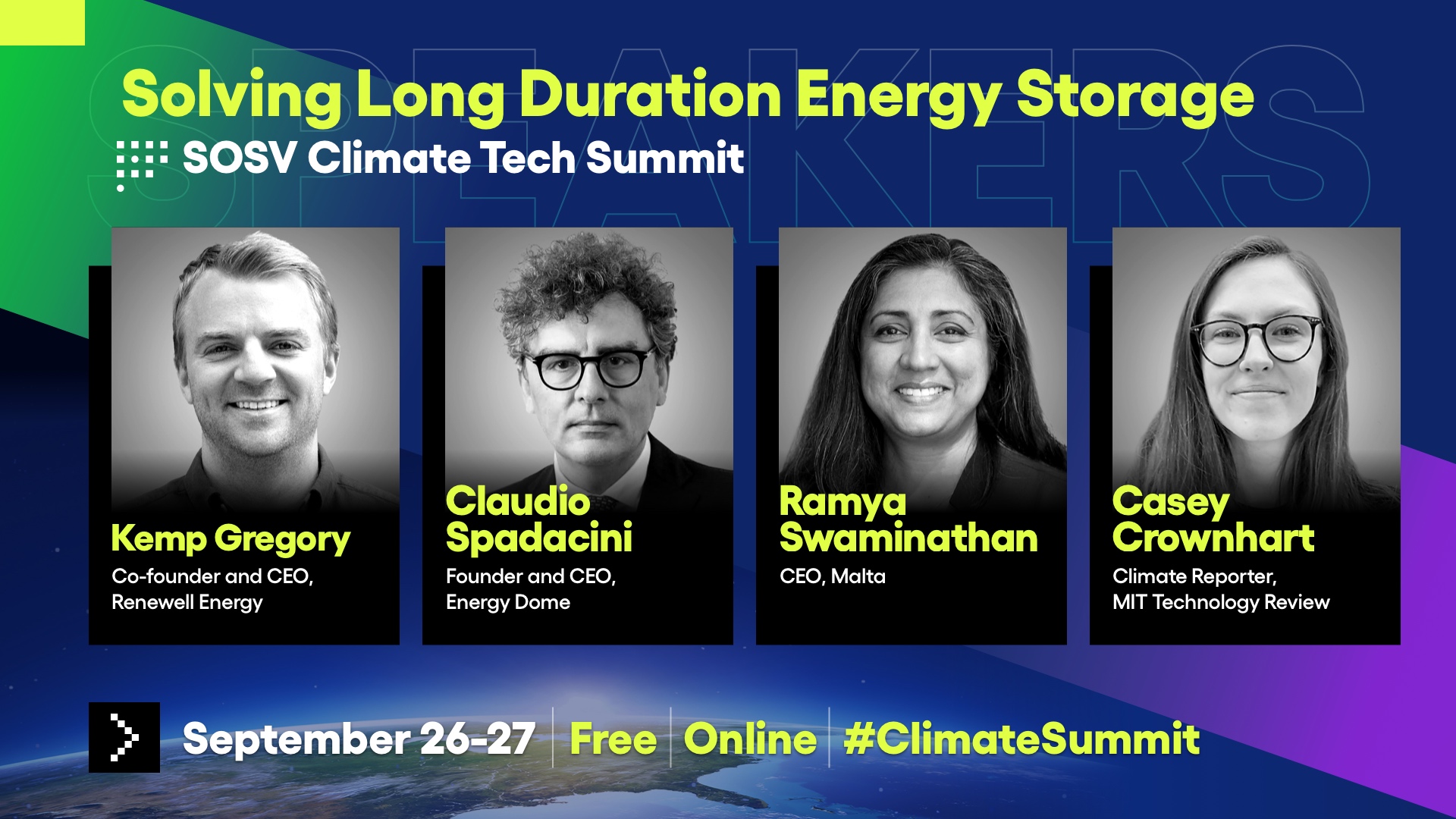
Wind and solar energy are a lynchpin in any realistic plan to curb climate change. They accounted for 12% of global electricity production in 2022 but are expected to surpass 40% by 2030, assuming we stay on course for net-zero emissions by 2050. Their weakness, however, is intermittency and the high cost of its remedy—storing energy when the sun and wind won’t cooperate. Without a revolution in long-duration (>10 hours), grid-level energy storage (>100 MW), renewables may flounder.
At this year’s SOSV Climate Tech Summit (Sept 26-27 / free & virtual ), we featured three startup founders who have raised millions to fill the energy storage gap with wildly innovative approaches: retired oil wells, molten salt and compressed CO2.
Research from the U.S. Department of Energy (DoE) shows that current storage options are not exactly affordable. The installed cost for pumped storage hydropower (PSH), the “dominant” option, or lithium-ion batteries and similar technologies typically is hundreds of dollars per kWh. Lithium-ion technology even grew more expensive in 2022 due to supply chain snarls, geopolitics, and mineral shortages.
The DoE—which runs an Energy Storage Grand Challenge to accelerate innovation—believes that emerging solutions using compressed air, gravity, and thermal technology could bring utility-level storage costs below $100/kWh and even down to the single digits. With global renewable energy capacity estimated to grow from 107 GW in 2022 to more than 440 GW by the end of 2023—the largest single-year increase ever—the need for a “Long Duration Storage Shot” ( the DoE’s word play on its “Earthshot” projects) success story is urgent.
The SOSV Climate Tech Summit (Sept 26-27 / free & virtual) welcomes three entrepreneurs at the forefront of this challenge. Can their storage technologies make solar and wind power dispatchable at an affordable price?
At Renewell Energy, CEO and co-founder Kemp Gregory aims to convert North America’s 2.6 million inactive oil and gas wells into clean energy storage systems. The idea is to store and release electricity by lifting and lowering a cylindrical weight sealed inside each well. At an estimated $5/kWh, this storage method is cost-effective and contains methane leaks as an added benefit. Launched in 2020 and based in Bakersfield, Calif. and Houston, Texas, Renewell graduated from SOVS’s HAX program and has since received $2.7 million in DoE grants and raised $3 million in seed funding from investors including SOSV, Third Sphere, and Preston-Werner Ventures, the VC fund of Github founder Thomas Preston-Werner.
Energy Dome, led by CEO and founder Claudio Spadacini, is developing a utility-scale, long-duration “CO2 battery.” It stores clean energy by compressing CO2 into liquid at ambient temperatures and then releases energy as needed by allowing that CO2 to expand into gas and drive a turbine. Energy Dome claims its systems will last for over 30 years without degradation and cost less than half as much as an equivalent lithium-ion system. Based in Milan, Italy, Energy Dome closed a €40M Series B in April 2023 led by Eni Next, the venture arm of Italian energy giant Eni, and co-led by Neva SGR, the venture wing of Intesa Sanpaolo, a European banking group. In total, Energy Dome has raised €54M.
Ramya Swaminathan, CEO of Malta Inc., leads a team developing thermo-electric energy storage. Built for electric utilities, grid operators, and industrial firms, Malta’s system uses electricity to drive a pump, which converts electrical energy into thermal energy by creating a temperature difference. The resultant heat, stored as molten salt, and cold, captured in antifreeze liquid, are the basis for a thermodynamic heat engine that drives an electric generator to produce power for the grid. Based in Cambridge, Mass., Malta incubated at X, Alphabet’s Moonshot Factory, and has raised $86M from investors including Proman (natural gas products), Breakthrough Energy Ventures, Chevron, Facebook co-founder Dustin Moskovitz, Alfa Laval (heat transfer, separation and fluid handling systems), and Piva Capital.
This panel was moderated by Casey Crownhart, climate reporter at the MIT Technology Review.
Which storage solutions will be the best solution for renewable energy sources? Watch the discussion below to find out—and tune into the rest of the sessions here.
The Speakers

Kemp Gregory
Kemp Gregory is CEO and a co-founder at Renewell Energy. Raised in the bays of his father’s small automotive repair shop, he graduated from the University of Texas at Austin in 2012 with a B.S. in mechanical engineering and took a job at Shell. He spent the next five years mastering hydraulic fracturing, installing cutting-edge downhole technology, managing capital-intensive projects, and coordinating large operations teams across North and South America. After earning his Master’s in renewable energy engineering from Stanford, Gregory founded Renewell to convert oil and gas’ largest liability into renewable energy’s greatest asset.

Claudio Spadacini
Claudio Spadacini holds a master’s degree in mechanical engineering, with a focus on Turbomachinery, Energy Production and Conversion from the Polytechnic University of Milan. He is Founder and CEO of Energy Dome, a leading provider of long-duration energy storage solutions. Prior to Energy Dome, Claudio founded and managed Exergy S.p.A., which has developed and installed more than 460 MWe of geothermal, waste heat recovery and CSP power plants under his guidance. Claudio also founded Sebigas S.p.A., which designs, constructs and manages biogas plants worldwide, and Idroelettrica Cavaglio, a developer of hydroelectric power plants using drilled rock tunnels.

Ramya Swaminathan
Ramya Swaminathan has developed Malta from concept to commercialization, guiding the company through multiple rounds of corporate venture funding and the recruitment of a multidisciplinary team. Ms. Swaminathan was named one of Business Insider’s “21 Rising Stars in Clean Energy” in 2020 and currently advises the U.S. Department of Energy as a member of the DOE Electricity Advisory Committee (EAC) and as a DOE Clean Energy Education and Empowerment (C3E) Ambassador. Before founding Malta, Ms. Swaminathan was the CEO of Rye Development, a hydropower development firm that she grew to be the leading developer of new hydropower and pumped hydro storage projects in the United States.

Casey Crownhart
Casey Crownhart is a climate reporter for MIT Technology Review, where she covers renewable energy, transportation, and climate policy. Her work has also appeared in outlets including Popular Science and Atlas Obscura. Casey graduated from NYU’s science journalism program and received her bachelor’s degree in chemical engineering and literature from MIT.

